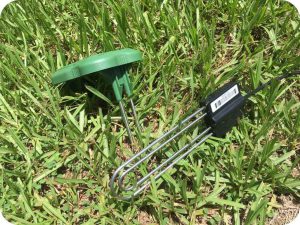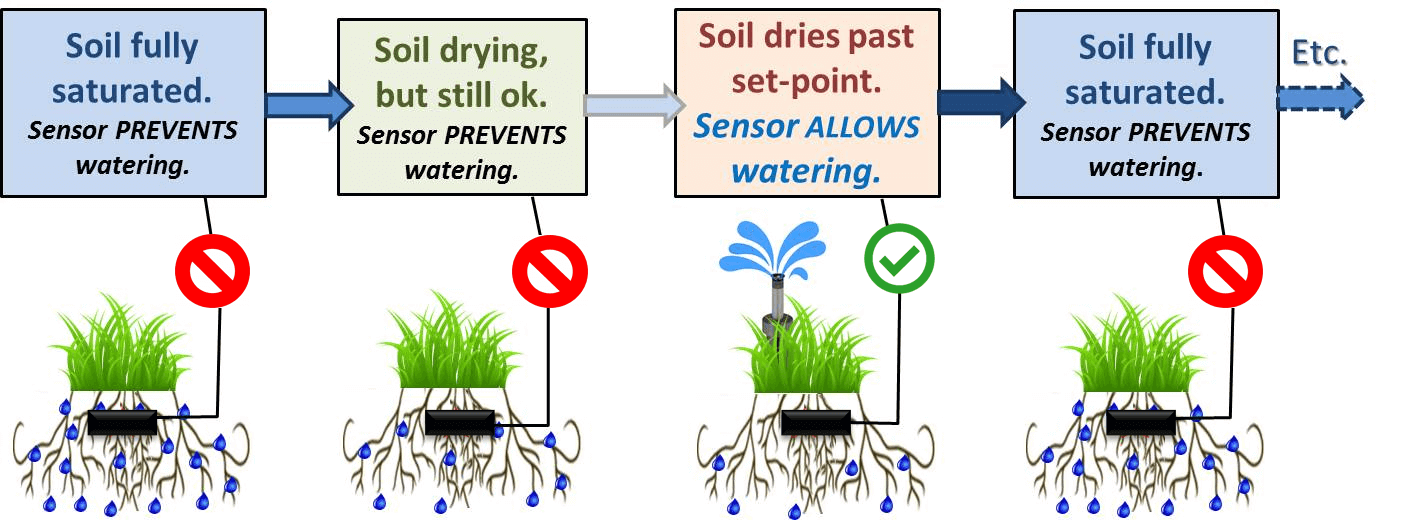(This is the second part of a series about how to take the guesswork out of watering the lawn. For part 1, click here.)
Measuring the moisture where it counts…at the roots.
Just over a decade ago, a UF/IFAS blogpost was published entitled “Soil-moisture Sensors May Produce Big Water Savings for Homeowners, UF Study Shows.” That post explained why in-ground sensors could help take the guesswork out of watering the lawn, potentially providing big water savings for Florida residents.

Now, ten years later, soil moisture sensors (SMS) are increasingly common in residential landscapes. (In fact, recently, more than 70% of the new homes built in Pasco County were permitted for SMS-equipped systems.) Of course, the big question is – “Are homeowners achieving those ‘big water savings’ mentioned in the 2007 blogpost?”
The basics
The idea is simple – Right before a sprinkler cycle runs, an in-ground sensor checks the soil’s moisture at the root-zone, in real-time.
If the ground is still wet enough, (either due to rainfall –or- the previous sprinkler cycle), the scheduled sprinkler cycle gets skipped. Voilà! Instant water savings. If instead, the ground is getting dry, the sensor allows the cycle to run as scheduled.

Research vs. Real-life
In research trials, the water savings of SMS were impressive. However, in the “real-world,” homeowners and irrigation contractors reported mixed reviews. Some SMS were certainly performing great and saving lots of water. But others definitely were not. For instance, an unoccupied model home with a SMS managed to use more than 130,000 gallons in a single month… during torrential FL summer rains?
Solving the mystery of the “vanishing water savings”
In Pasco County, SMS devices have become increasingly common. Recently, Pasco County Utilities’ Water Conservation & Efficiency Coordinator and the UF/IFAS Florida Friendly Landscaping (FFL) Program Coordinator teamed up to help troubleshoot a series of situations involving “vanishing SMS water savings.” In each case, an SMS-equipped system appeared to be allowing much higher water usage than would be expected. (To make things complicated, there didn’t appear to be a consistent problem with any particular model or brand of SMS…)
Detective work…
After working with homeowners, builders, irrigation contractors, SMS manufacturers, and the UF/IFAS “Irri-gator” research team, several common themes began to appear. It turns out that the title of that 2007 blogpost was surprisingly spot-on.
These sensors may produce big water savings and they certainly can take the guesswork out of watering…BUT… correct location, calibration, and wiring are absolutely critical for achieving those water savings.
What were initially overlooked as minor differences in installation and setup methods were actually causing major differences in water-saving performance. In the next segment of this multi-part series, we’ll review a few of the real-life mistakes that can cause the expected water savings to evaporate. More importantly, I’ll provide some tips to help you get the best performance from soil moisture sensors and take the guesswork out of watering the lawn…
About UF/IFAS Extension:
UF/IFAS Extension serves as a source of non-biased, research-based information for the residents, businesses, and communities of Florida, providing educational materials and programs for adults and youth. We proudly “provide solutions for your life.”
UF/IFAS has local Extension offices throughout the state! Click to find your local office!
by Frank Galdo
 0
0
